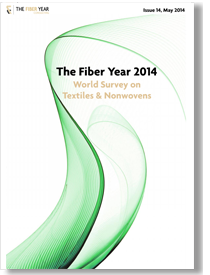 The contribution of the ten largest producing countries in natural fibers growing, manmade fiber and spunbond manufacturing has been analyzed over a period from 2005 until 2013. While the global production volume has increased from 74 million to 95 million tonnes in that period the share of the ten largest manufacturing countries has improved from 78% to 86%. Meanwhile, the average annual growth rate of consumption within this group of countries merely rose less than 1% to reach almost 52 million tonnes in 2013. Hence, the gap between production and consumption has widened.
The contribution of the ten largest producing countries in natural fibers growing, manmade fiber and spunbond manufacturing has been analyzed over a period from 2005 until 2013. While the global production volume has increased from 74 million to 95 million tonnes in that period the share of the ten largest manufacturing countries has improved from 78% to 86%. Meanwhile, the average annual growth rate of consumption within this group of countries merely rose less than 1% to reach almost 52 million tonnes in 2013. Hence, the gap between production and consumption has widened.
As a direct response the textile and apparel export value of these countries has more than doubled to reach USD450 billion in 2013. Expanded manufacturing capacities along the textile chain have resulted in a marginal growth of textile and apparel imports from USD154 billion in 2005 to USD188 billion in 2013.
Higher trade dynamics have been witnessed in worn clothing and articles. Imports more than doubled to around USD330 million while exports tripled to nearly USD1.3 billion. Consequentially, the joint trade surplus has improved from USD270 million to USD935 million. Major net exporters of worn clothing and articles are the United States, Korea, PR China and Taiwan with a consolidated surplus arriving almost at 1.2 million tonnes. The largest net importers in volume terms are Pakistan and India, their joint trade deficit accounts for 0.6 million tonnes. Corresponding trade volumes in Bangladesh, Brazil, Indonesia and Turkey are negligible.
The outlook 2020 refers to the anticipated production and consumption volumes for this group of countries. A slowdown in production reflects regional dynamics that suggest slowing fiber consumption in advanced economies which are currently characterized by above average textile demand. A market size in the range of 115 million tonnes appears realistic in the year 2020, of which more than half will be consumed in the ten analyzed nations. The forecast in national demand takes into consideration the recent consumption level in the period 2009 to 2013, GDP growth rates from 2014 to 2020, the current income category and demographic development.
Finally, charts illustrate the correlation between income and textile consumption over the entire period of time for each country. The entire 63-page report is available online.
Author
Andreas W. Engelhardt
Source
The Fiber Year, press release, 2014-11.
Supplier
Share
Renewable Carbon News – Daily Newsletter
Subscribe to our daily email newsletter – the world's leading newsletter on renewable materials and chemicals










